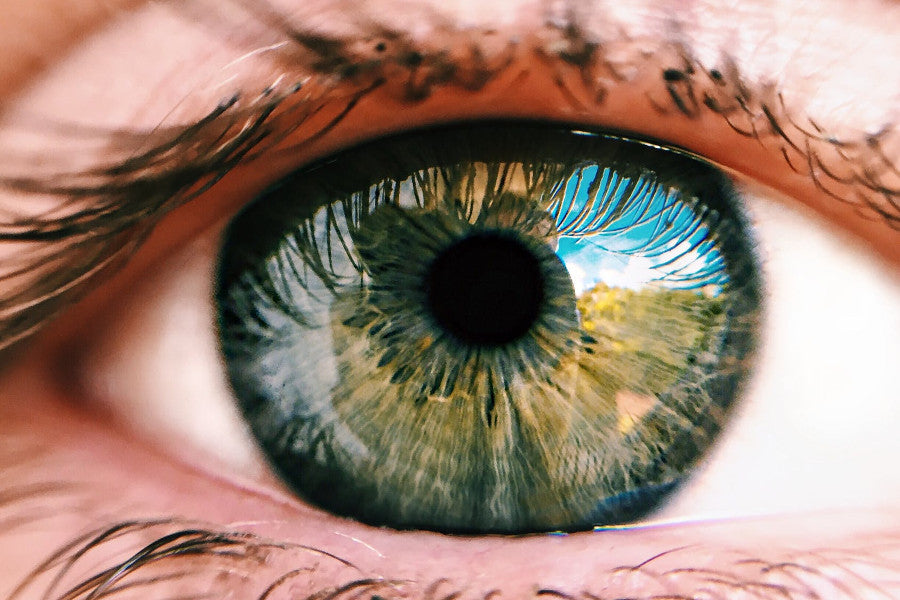When it comes to colour, men and women really don't see eye to eye ! Females are better at discriminating more colours, while males excel at tracking fast-moving objects and discerning detail from a distance. Researchers believe this may be an evolutionary adaptation linked to our hunter-gatherer past.
The average human can perceive one million different colours, but researchers suspect that a small percentage of women may be capable of seeing one hundred times that amount. Normally, people have just three types of cone cells for detecting different colours, but some women have four. They are called tetrachromats. The theory is that tetrachromats have an extra cone type as a result of a mutation. This mutation happens on the X chromosome. Women inherit two X chromosomes, so if a mutation occurs on both chromosomes, they have the potential of being a tetrachromat. As men only inherit one X chromosome, any mutations that occur would result in them having anomalous trichromacy.
When looking at a rainbow, these females can segment it into about 10 different colours, while people with three cones can see only seven: red, orange, yellow, green, blue, indigo and violet. Perhaps that’s why research has shown that women were more likely than men to have a favourite colour and that women prefer tints to shades, while men tend to prefer simple, strong colours. So, when you are discussing the health and texture of your hair, you may want to ask a woman to be the judge. Not only is she more likely to see more colours, she may be able to describe them better too.
Human Hair Colour
Hair colour is the pigmentation of hair follicles due to two types of melanin: eumelanin and pheomelanin. Basically, eumelanin is a pigment that is responsible for dark shade colour, from brown to black. It also protects your skin from damages of the direct sunlight. While pheomelanin is responsible for the light colours, such as golden blond and red. But it can not protect the skin from damage. In some cases, if your hair lacks one of these melanins, your hair colour is white or a grey colour.
Natural hair colours are usually in dark or light shades. Basically, it is in five different colours: black, brown, blonde, red, grey and white.
Black Hair
Being the darkest human hair colour, the eumelanin in black hair is denser than the others. It is also the most popular colour of human hair. Black hair is particularly common around the world, from Asia, Latin America, Southern Europe, to Africa.
Brown Hair
It is the second most popular natural human hair colour, after the black. It comes from light to medium and dark brown. Again brown hair is characterised by the level of eumelanin melanin. Brown is often known as brunette. Hence, the light or dark shades of brown hair also refer to the shade of brunette. Each type of brown hair has its name, such as chestnut, auburn hair, caramel brown, light golden - unless your a man !
Blonde Hair
Blonde (blond) varies from nearly white (platinum blonde) to a dark golden blonde. Studies have shown that natural light blonde hair is rare in adulthood - only 2% of the world’s population! Like brown hair, the blonde comes in different shades and sources such as ash-blonde, platinum blonde, golden blonde, yellow, and so on...
Red Hair
The hair colour that has the highest amounts of pheomelanin and low levels of eumelanin. It's uncommon in the world now although Scotland has the highest proportion of red hair with 13% of the population!
Grey Hair
This usually appears naturally due to people’s age. Typically, the hair of Asian people starts turning into grey colour in their late 30s. Most Africans hairs are still in their original hair colour until they are in their mid-40s. While the hair of Europeans changes to grey early, in their mid-30.
The look of healthy hair
Human hair is made up mostly of keratin, a protein that contains melanin, a pigment that gives hair its colour. It also contains trace amounts of vitamins, zinc, and other metals. About 10 to 13 percent of hair is made up of water which is essential to keep your hair supple and avoid breakage and splitting. The health of your hair health depends on the nutrients you supply internally and what you expose it to externally. Healthy hair is supple, lustrous and vibrant. The outside layer of the hair is the cuticle which protects the hair shaft against external damage from chemicals, abrasion and UV exposure. It also retains moisture. The cuticle on healthy, growing hair is smooth and reflects light evenly. Healthy hair proudly displays its full colour, with all its unique pigmentation.
Keep the colour
Changes in hair colour typically occur naturally as people age, eventually turning the hair grey and then white. The change in hair colour occurs when melanin ceases to be produced in the hair root and new hairs grow in without pigment.
Healthy hair is one of the key's to keeping your colour and whether you are a woman who can see 99 million colours or an observant man, healthy-looking hair is a gift worth protecting!
Keep Your Hair Healthy
Recent research has shown that exposure to low-level laser light can halt or even reverse hair loss and keep your hair healthy. HairMax has conducted more clinical studies than any other laser manufacturer and has demonstrated to the satisfaction of the FDA that their laser devices deliver therapeutic light energy to your hair follicles and can actually reverse thinning and stimulate fuller, denser hair growth. It’s a simple therapy that can be carried out at home in as little as 90 seconds 3 times a week. Experts point out that the sooner you start treatment the better – because everyone’s hair follicles weaken, shrink, and can even die. And once that happens, they can never again grow hair. The change in hair colour occurs when melanin ceases to be produced in the hair root and new hairs grow in without pigment. When you practice laser therapy, you stimulate new hair growth and those new hairs will exhibit your original, deeper pigmentation.

- by Stephen Dowd
What colour is your hair ?
- by Stephen Dowd



Share:
Moisture Conditioning
The Link Between Weight Loss and Hair Loss